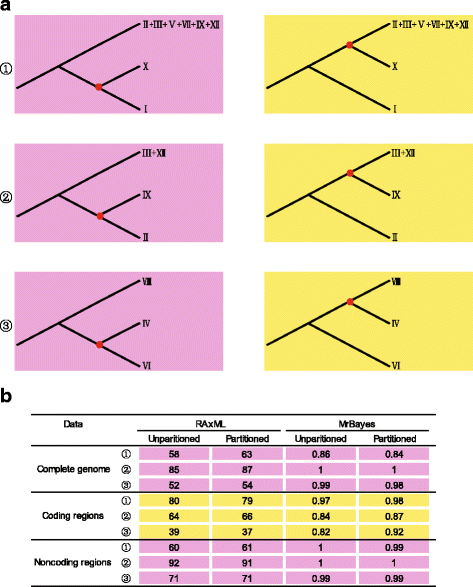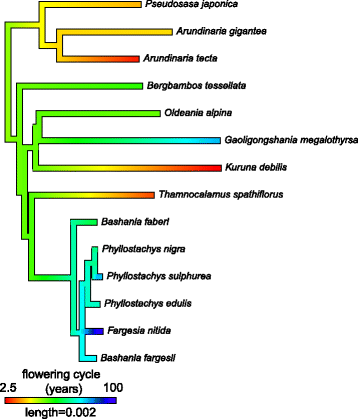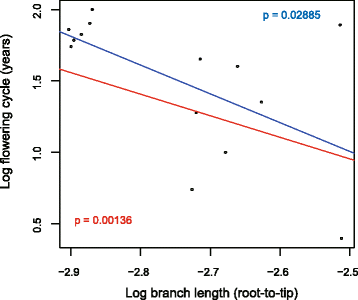Negative correlation between rates of molecular evolution and flowering cycles in temperate woody bamboos revealed by plastid phylogenomics
- PMID: 29268709
- PMCID: PMC5740905
- DOI: 10.1186/s12870-017-1199-8
Negative correlation between rates of molecular evolution and flowering cycles in temperate woody bamboos revealed by plastid phylogenomics
Abstract
Background: Heterogeneous rates of molecular evolution are universal across the tree of life, posing challenges for phylogenetic inference. The temperate woody bamboos (tribe Arundinarieae, Poaceae) are noted for their extremely slow molecular evolutionary rates, supposedly caused by their mysterious monocarpic reproduction. However, the correlation between substitution rates and flowering cycles has not been formally tested.
Results: Here we present 15 newly sequenced plastid genomes of temperate woody bamboos, including the first genomes ever sequenced from Madagascar representatives. A data matrix of 46 plastid genomes representing all 12 lineages of Arundinarieae was assembled for phylogenetic and molecular evolutionary analyses. We conducted phylogenetic analyses using different sequences (e.g., coding and noncoding) combined with different data partitioning schemes, revealing conflicting relationships involving internodes among several lineages. A great difference in branch lengths were observed among the major lineages, and topological inconsistency could be attributed to long-branch attraction (LBA). Using clock model-fitting by maximum likelihood and Bayesian approaches, we furthermore demonstrated extensive rate variation among these major lineages. Rate accelerations mainly occurred for the isolated lineages with limited species diversification, totaling 11 rate shifts during the tribe's evolution. Using linear regression analysis, we found a negative correlation between rates of molecular evolution and flowering cycles for Arundinarieae, notwithstanding that the correlation maybe insignificant when taking the phylogenetic structure into account.
Conclusions: Using the temperate woody bamboos as an example, we found further evidence that rate heterogeneity is universal in plants, suggesting that this will pose a challenge for phylogenetic reconstruction of bamboos. The bamboos with longer flowering cycles tend to evolve more slowly than those with shorter flowering cycles, in accordance with a putative generation time effect.
Keywords: Generation time; Infrequent flowering; Molecular evolution; Plastid phylogenomics; Rate heterogeneity; Temperate woody bamboos.
Conflict of interest statement
Ethics approval and consent to participate
Not applicable.
Consent for publication
Not applicable.
Competing interests
The authors declare that they have no competing interests.
Publisher’s Note
Springer Nature remains neutral with regard to jurisdictional claims in published maps and institutional affiliations.
Figures





References
-
- Yang Y, Moore MJ, Brockington SF, Soltis DE, Wong GKS, Carpenter EJ, Zhang Y, Chen L, Xie Y, Sage RF, Covshoff S, Hibberd JM, Nelson MN, Smith SA. Dissecting molecular evolution in the highly diverse plant clade Caryophyllales using transcriptome sequencing. Mol Biol Evol. 2015;32:2001–2014. doi: 10.1093/molbev/msv081. - DOI - PMC - PubMed
-
- Gaut BS, Morton BR, McCaig BC, Clegg MT. Substitution rate comparisons between grasses and palms: synonymous rate differences at the nuclear gene Adh parallel rate differences at the plastid gene rbcL. Proc Natl Acad Sci U S A. 1996;93:10274–10279. doi: 10.1073/pnas.93.19.10274. - DOI - PMC - PubMed
Publication types
MeSH terms
Grants and funding
LinkOut - more resources
Full Text Sources
Other Literature Sources
Molecular Biology Databases

